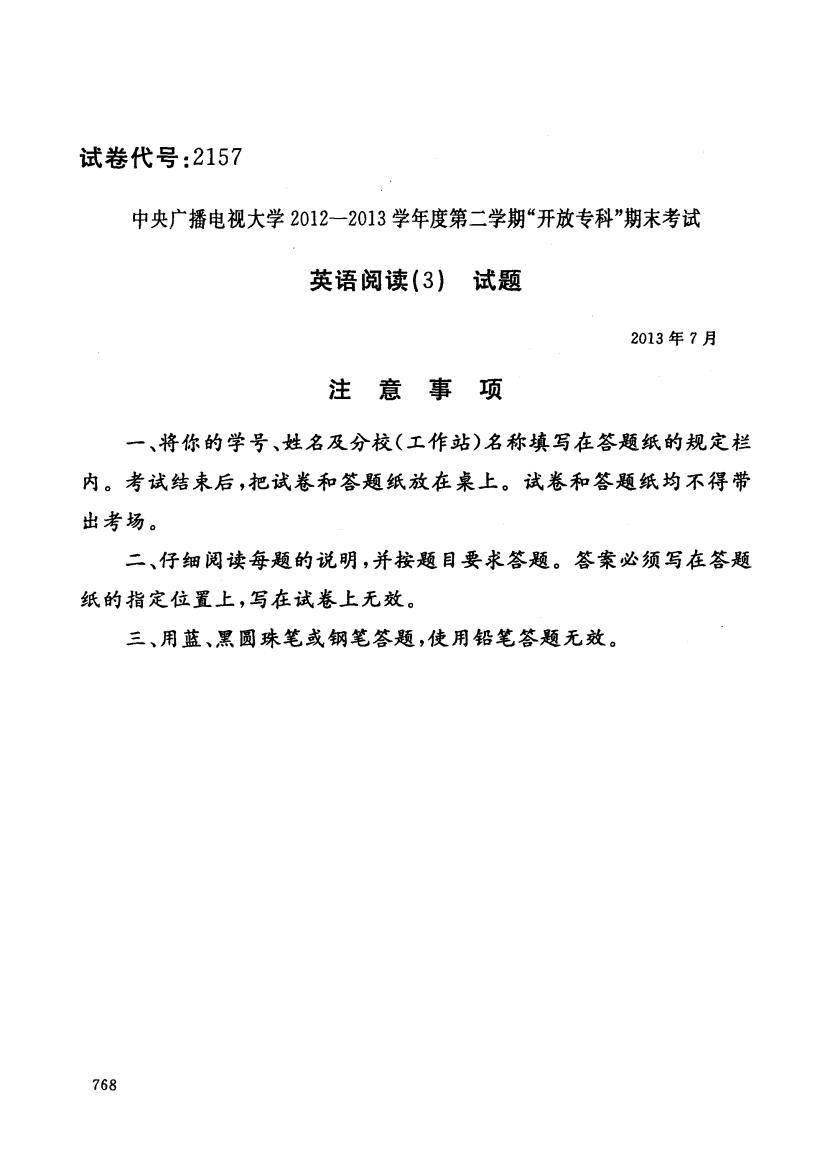
试卷代号:2157 中央广播电视大学2012一2013学年度第二学期“开放专科”期末考试 英语阅读(3)试题 2013年7月 注意事项 一、将你的学号、姓名及分校(工作站)名称填写在答题纸的规定栏 内。考试结束后,把试卷和答题纸放在桌上。试卷和答题纸均不得带 出考场。 二、仔细阅读每题的说明,并按题目要求答题。答案必须写在答题 纸的指定位置上,写在试卷上无效。 三、用蓝、黑圆珠笔或钢笔答题,使用铅笔答题无效。 768
试卷代号 中央广播电视大学 2 0 3学年度第二学期"开放专科"期末考试 英语阅读 试题 2013 年7 注意事项 一、将你的学号、姓名及分校〈工作站)名称填写在答题纸的规定栏 内。考试结束后,把试卷和答题纸放在桌上。试卷和答题纸均不得带 出考场。 二、仔细阅读每题的说明,并按题目要求答题。答案必须写在答题 纸的指定位置上,写在试卷上无效。 三、用蓝、黑圆珠笔或钢笔答题,使用铅笔答题无效。 768
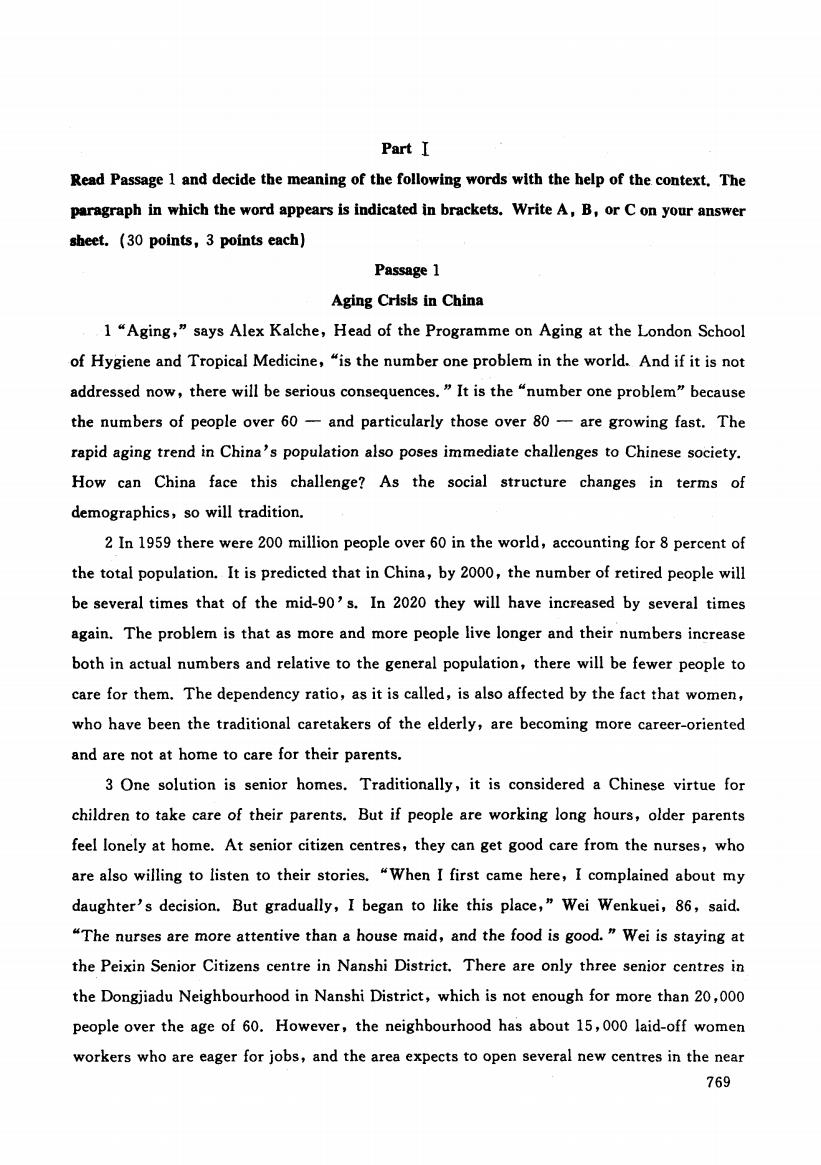
Part I Read Passage 1 and decide the meaning of the following words with the help of the context.The paragraph in which the word appears is indicated in brackets.Write A,B,or C on your answer sheet.(30 points,3 points each) Passage 1 Aging Crists in China 1 "Aging,says Alex Kalche,Head of the Programme on Aging at the London School of Hygiene and Tropical Medicine,"is the number one problem in the world.And if it is not addressed now,there will be serious consequences."It is the "number one problem"because the numbers of people over 60-and particularly those over 80-are growing fast.The rapid aging trend in China's population also poses immediate challenges to Chinese society. How can China face this challenge?As the social structure changes in terms of demographics,so will tradition. 2 In 1959 there were 200 million people over 60 in the world,accounting for 8 percent of the total population.It is predicted that in China,by 2000,the number of retired people will be several times that of the mid-90's.In 2020 they will have increased by several times again.The problem is that as more and more people live longer and their numbers increase both in actual numbers and relative to the general population,there will be fewer people to care for them.The dependency ratio,as it is called,is also affected by the fact that women, who have been the traditional caretakers of the elderly,are becoming more career-oriented and are not at home to care for their parents. 3 One solution is senior homes.Traditionally,it is considered a Chinese virtue for children to take care of their parents.But if people are working long hours,older parents feel lonely at home.At senior citizen centres,they can get good care from the nurses,who are also willing to listen to their stories."When I first came here,I complained about my daughter's decision.But gradually,I began to like this place,"Wei Wenkuei,86,said. "The nurses are more attentive than a house maid,and the food is good."Wei is staying at the Peixin Senior Citizens centre in Nanshi District.There are only three senior centres in the Dongjiadu Neighbourhood in Nanshi District,which is not enough for more than 20,000 people over the age of 60.However,the neighbourhood has about 15,000 laid-off women workers who are eager for jobs,and the area expects to open several new centres in the near 769
Part I ReadP 姐ge 1 and 民ide the meaning of the following words with the help of the context. The par raph in which the word appears is indicated in brackets. Write A. B. or C on your answer 曲目 (30 points. 3 points each) Passage 1 Aging Crisis in China 1 "Aging," says Alex Kalche , Head of the Programme on Aging at the London School of Hygiene and Tropical Medicine , "is the number one problem in the world. And if it is not addressed now , there will be serious consequences. " It is the "number one problem" because the numbers of people over 60 - and particularly those over 80 - are growing fast. The rapid aging trend in China's population also poses immediate challenges to Chinese society. How can China face this challenge? As the social structure changes in terms of demographics. so will tradition. 2 In 1959 there were 200 million people over 60 in the world , accounting for 8 percent of the total population. It is predicted that in China , by 2000. the number of retired people will be several times that of the mid-90' s. In 2020 they will have increased by several times again. The problem is that as more and more people live longer and their numbers increase both in actual numbers and relative to the general population , there will be fewer people to care for them. The dependency ratio. as it is called , is also affected by the fact that women , who have been the traditional caretakers of the elderly, are becoming more career-oriented and are not at home to care for their parents. 3 One solution is senior homes. Traditionally , it is considered a Chinese virtue for children to take care of their parents. But if people are working long hours, older parents feellonely at home. At senior citizen centres, they can get good care from the nurses, who are also willing to listen to their stories. "When I first came here , I complained about my daughter's decision. But gradually. I began to like this place ," Wei Wenkuei. 86 , said. "The nurses are more attentive than a house maid , and the food is good. " Wei is staying at the Peixin Senior Citizens centre in Nanshi District. There are only three senior centres in the Dongjiadu Neighbourhood in Nanshi District, which is not enough for more than 20 ,000 people over the age of 60. However, the neighbourhood has about 15 ,000 laid-off women workers who are eager for jobs, and the area expects to open several new centres in the near 769
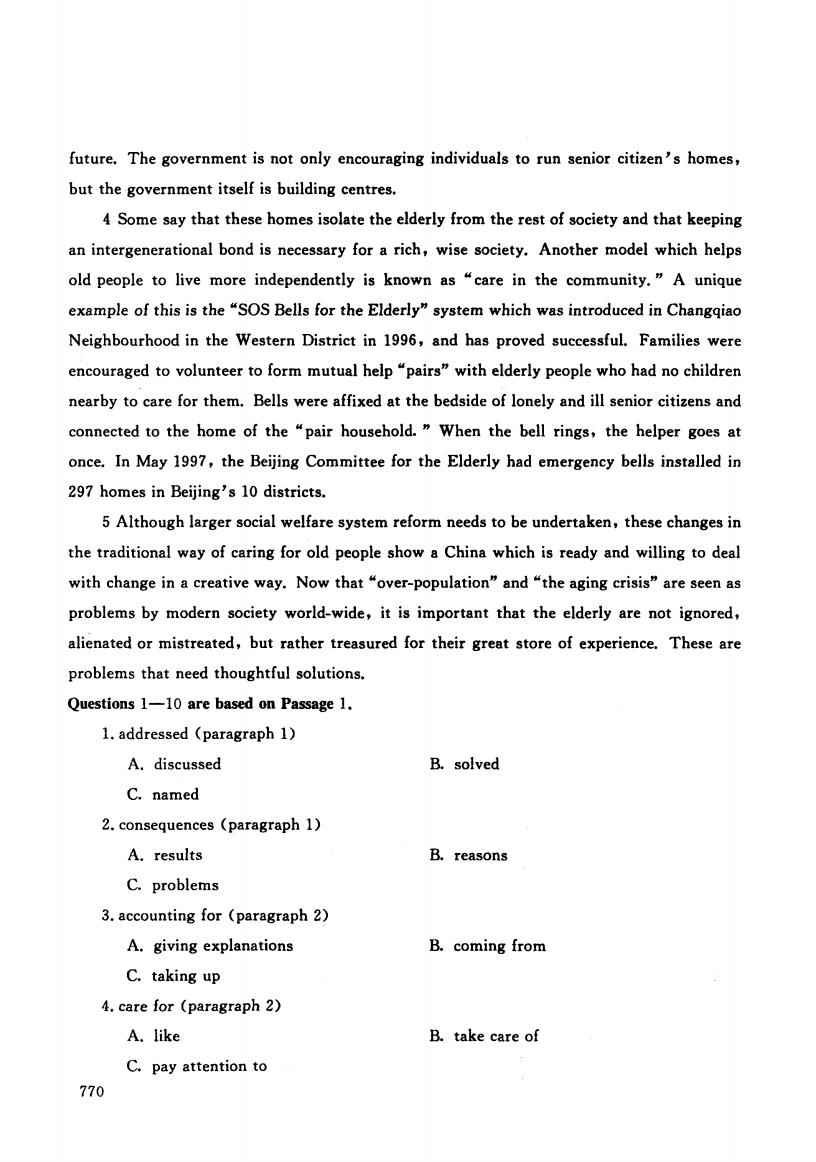
future.The government is not only encouraging individuals to run senior citizen's homes, but the government itself is building centres. 4 Some say that these homes isolate the elderly from the rest of society and that keeping an intergenerational bond is necessary for a rich,wise society.Another model which helps old people to live more independently is known as "care in the community."A unique example of this is the "SOS Bells for the Elderly"system which was introduced in Changqiao Neighbourhood in the Western District in 1996,and has proved successful.Families were encouraged to volunteer to form mutual help"pairs"with elderly people who had no children nearby to care for them.Bells were affixed at the bedside of lonely and ill senior citizens and connected to the home of the "pair household."When the bell rings,the helper goes at once.In May 1997,the Beijing Committee for the Elderly had emergency bells installed in 297 homes in Beijing's 10 districts. 5 Although larger social welfare system reform needs to be undertaken,these changes in the traditional way of caring for old people show a China which is ready and willing to deal with change in a creative way..Now that“over-population”and“the aging crisis”are seen as problems by modern society world-wide,it is important that the elderly are not ignored, alienated or mistreated,but rather treasured for their great store of experience.These are problems that need thoughtful solutions. Questions 1-10 are based on Passage 1. 1.addressed(paragraph 1) A.discussed B.solved C.named 2.consequences (paragraph 1) A.results B.reasons C.problems 3.accounting for (paragraph 2) A.giving explanations B.coming from C.taking up 4.care for (paragraph 2) A.like B.take care of C.pay attention to 770
B. solved future. The government is not only encouraging individuals to run senior citizen's homes, but thegovernment itself is building centres. 4 Some say that these homes isolate the elderly from the rest of society and that keeping an intergenerational bond is necessary for a rich , wise society. Another model which helps old people to live more independently is known as "care in the community." A unique example of this is the "sos Bells for the Elderly" system which was introduced in Changqiao Neighbourhood in the Western District in 1996 , and has proved successful. Families were encouraged to volunteer to form mutual help "pairs" with elderly people who had no children nearby to care for them. Bells were affixed at the bedside of lonely and ill senior citizens and connected to the home of the "pair household. " When the bell rings, the helper goes at once. In May 1997 , the Beijing Committee for the Elderly had emergency bells installed in 297 homes in Beijing's 10 districts. 5 Although larger social welfare system reform needs to be undertaken , these changes in the traditional way of caring for old people show a China which is ready and willing to deal with change in a creative way. Now that "over-population" and "the aging crisis" are seen as problems by modern society world-wide , it is important that the elderly are not ignored , alienated or mistreated , but rather treasured for their great store of experience. These are problems that need thoughtful solutions. Questions 一10 are based on Passage 1. 1. addressed (paragraph 1) A. discussed C. named 2. consequences (paragraph 1) A. results C. problems 3. accounting for (paragraph 2) A. giving explanations C. taking up 4. care for (paragraph 2) A. like C. pay attention to 770 B. reasons B. coming from B. take care of
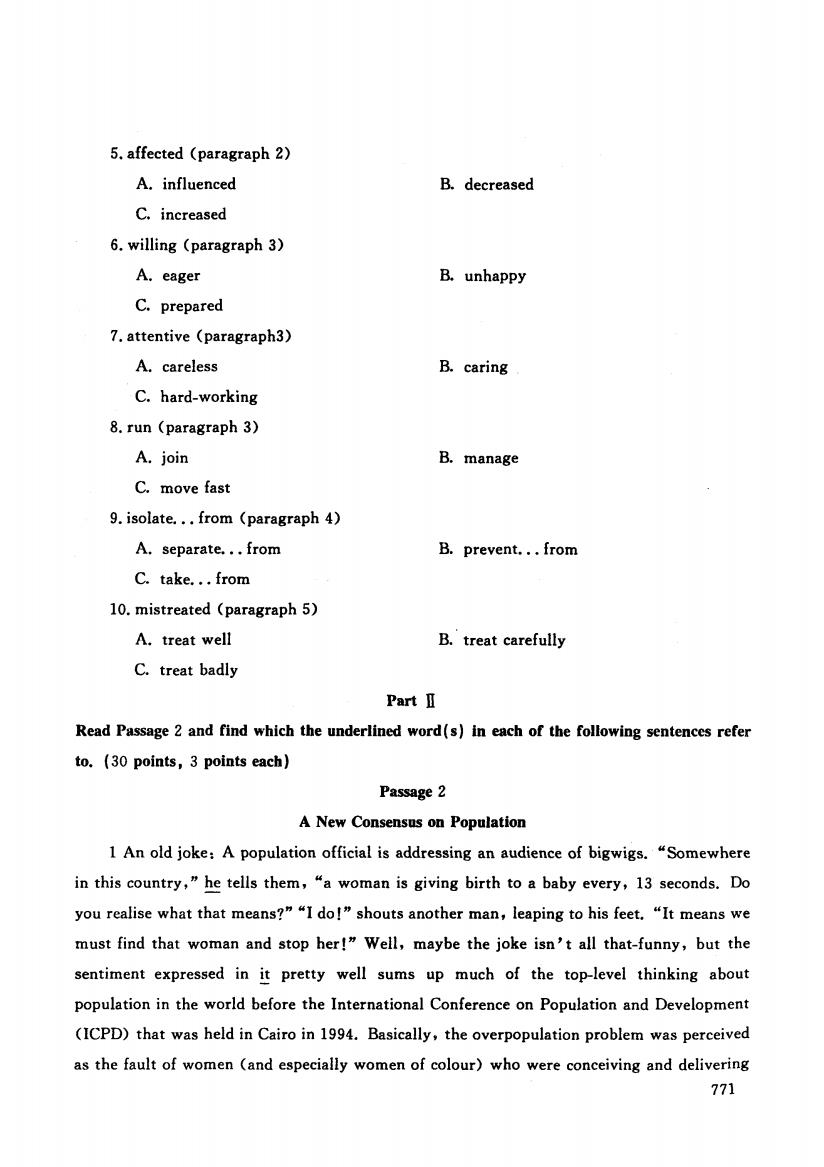
5,affected (paragraph 2) A.influenced B.decreased C.increased 6.willing (paragraph 3) A.eager B.unhappy C.prepared 7.attentive (paragraph3) A.careless B.caring C.hard-working 8.run (paragraph 3) A.join B.manage C.move fast 9.isolate...from (paragraph 4) A.separate...from B.prevent...from C.take...from 10.mistreated (paragraph 5) A.treat well B.treat carefully C.treat badly Part I Read Passage 2 and find which the underlined word(s)in each of the following sentences refer to.(30 points,3 points each) Passage 2 A New Consensus on Population 1 An old joke:A population official is addressing an audience of bigwigs."Somewhere in this country,"he tells them,"a woman is giving birth to a baby every,13 seconds.Do you realise what that means?”“Idol”shouts another man,leaping to his feet.“It means we must find that woman and stop her!"Well,maybe the joke isn't all that-funny,but the sentiment expressed in it pretty well sums up much of the top-level thinking about population in the world before the International Conference on Population and Development (ICPD)that was held in Cairo in 1994.Basically,the overpopulation problem was perceived as the fault of women (and especially women of colour)who were conceiving and delivering 771
5. affected (paragraph 2) A. influenced C. increased 6. willing (paragraph 3) A. eager C. prepared 7. attentive (paragraph3) A. careless C. hard-working 8. run (paragraph 3) A. join C. move fast 9. isolate. • • from (paragraph 4) A. separate... from C. take... from 10. mistreated (paragraph 5) A. treat well C. treat badly B. decreased B. unhappy B. caring B. manage B. prevent... from B. treat carefully Part II Read Passage 2 and find which the underlined word (s) 回ch of the following sentences refer to. (30 points. 3 points 回ch) 2 A New Consensus on Population 1 An old joke: A population official is addressing an audience of bigwigs. "Somewhere in this country ," he tells them , "a woman is giving birth to a baby every , 13 seconds. Do you realise what that means?" "I do!" shouts another man , leaping to his feet. "It means we must find that woman and stop hed" Well, maybe the joke isn't all that-funny , but the sentiment expressed in i! pretty well sums up much of the top-level thinking about population in the world before the International Conference on Population and Development (lCPD) that was held in Cairo in 1994. Basically, the overpopulation problem was perceived as the fault of women (and especially women of colour) who were conceiving and delivering 771
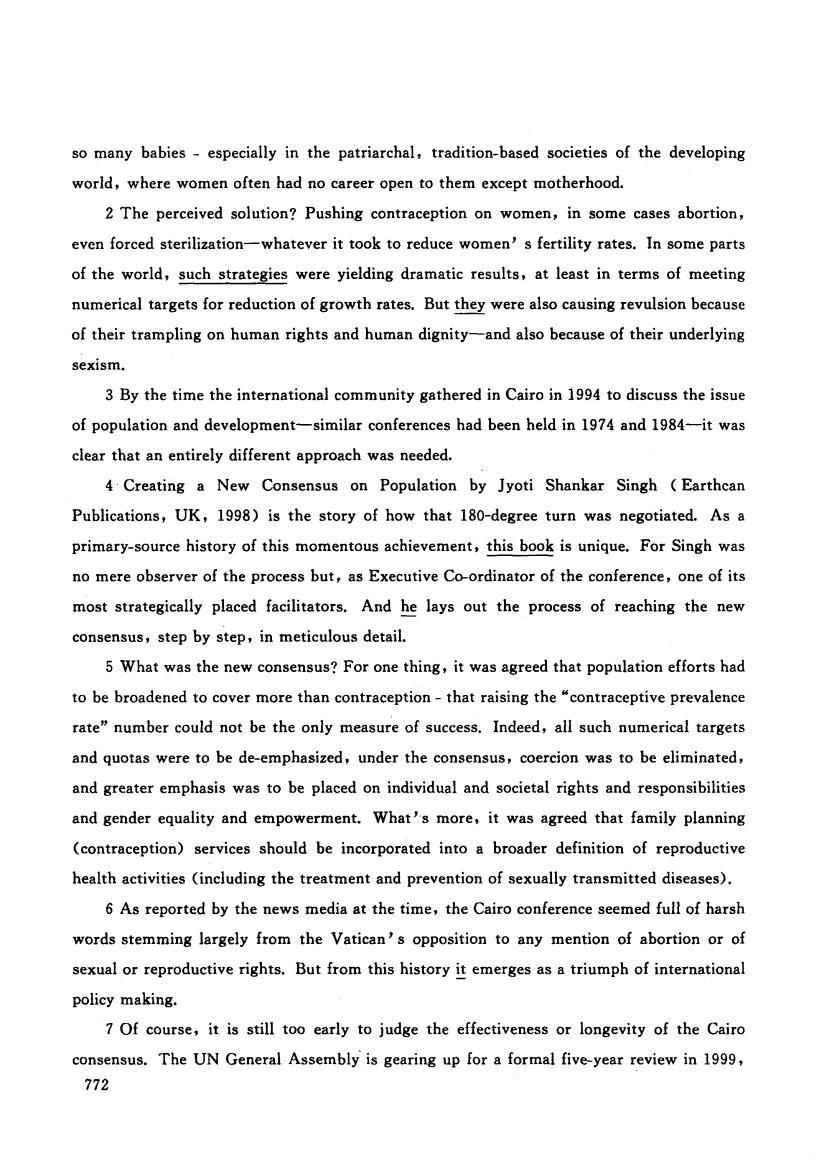
so many babies-especially in the patriarchal,tradition-based societies of the developing world,where women often had no career open to them except motherhood. 2 The perceived solution?Pushing contraception on women,in some cases abortion, even forced sterilization-whatever it took to reduce women's fertility rates.In some parts of the world,such strategies were yielding dramatic results,at least in terms of meeting numerical targets for reduction of growth rates.But they were also causing revulsion because of their trampling on human rights and human dignity-and also because of their underlying sexism. 3 By the time the international community gathered in Cairo in 1994 to discuss the issue of population and development-similar conferences had been held in 1974 and 1984-it was clear that an entirely different approach was needed. 4 Creating a New Consensus on Population by Jyoti Shankar Singh Earthcan Publications,UK,1998)is the story of how that 180-degree turn was negotiated.As a primary-source history of this momentous achievement,this book is unique.For Singh was no mere observer of the process but,as Executive Co-ordinator of the conference,one of its most strategically placed facilitators.And he lays out the process of reaching the new consensus,step by step,in meticulous detail. 5 What was the new consensus?For one thing,it was agreed that population efforts had to be broadened to cover more than contraception-that raising the "contraceptive prevalence rate"number could not be the only measure of success.Indeed,all such numerical targets and quotas were to be de-emphasized,under the consensus,coercion was to be eliminated, and greater emphasis was to be placed on individual and societal rights and responsibilities and gender equality and empowerment.What's more,it was agreed that family planning (contraception)services should be incorporated into a broader definition of reproductive health activities (including the treatment and prevention of sexually transmitted diseases). 6 As reported by the news media at the time,the Cairo conference seemed full of harsh words stemming largely from the Vatican's opposition to any mention of abortion or of sexual or reproductive rights.But from this history it emerges as a triumph of international policy making. 7 Of course,it is still too early to judge the effectiveness or longevity of the Cairo consensus.The UN General Assembly is gearing up for a formal five-year review in 1999, 772
so many babies - especially in the patriarchal , tradition-based societies of the developing world , where women often had no career open to them except motherhood. 2 The perceived solution? Pushing contraception on women, in some cases abortion , even forced sterilization-whatever it took to reduce women' s fertility rates. In some parts of the world ,such strategies were yielding dramatic results, at least in terms of meeting numerical targets for reduction of growth rates. But they were also causing revulsion because of their trampling on human rights and human dignity-and also because of their underlying sexIsm. 3 By the time the international community gathered in Cairo in 1994 to discuss the issue of population and development-similar conferences had been held in 1974 and 1984一it was clear that an entirely different approach was needed. 4 Creating a New Consensus on Population by ]yoti Shankar Singh (Earthcan Publications, UK , 1998) is the story of how that 180-degree turn was negotiated. As a primary-source history of this momentous achievement, this book is unique. For Singh was no mere observer of the process but , as Executive Co-ordinator of the conference , one of its most strategically placed facilitators. And he lays out the process of reaching the new consensus, step by step , in meticulous detail. 5 What was the new consensus? For one thing , it was agreed that population efforts had to be broadened to cover more than contraception - that raising the "contraceptive prevalence rate" number could not be the only measure of success. Indeed , all such numerical targets and quotas were to be de-emphasized , under the consensus, coercion was to be eliminated , and greater emphasis was to be placed on individual and societal rights and responsibilities and gender equality and empowerment. What's more , it was agreed that family planning (contraception) services should be incorporated into a broader definition of reproductive health activities <including the treatment and prevention of sexually transmitted diseases). 6 As reported by the news media at the time , the Cairo conference seemed full of harsh words stemming largely from the Vatican' s opposition to any mention of abortion or of sexual or reproductive rights. But from this history it emerges as a triumph of international policy making. 7 Of course , it is still too early to judge the effectiveness or longevity of the Cairo consensus. The UN General Assembly is gearing up for a formal five-year review in 1999 , 772

but the early evidence is not especially encouraging.Non-participants in the debate seem unable to grasp the significance of reproductive health-or to understand why it deserves any more attention than,say,cardio-pulmonary health or mental health.And the major family planning agencies,struggling to find a new way of working under its directions,report widespread confusion in their ranks and disillusionment among their supporters.And the international financial support for population programs that was anticipated at the Cairo conference has yet to materialise. 8 Still,ICPD was unique among UN conferences and surely Jyoti Shankar Singh is unique among international bureaucrats:He not only commands an extraordinary grasp of the intricacies of the UN system of diplomacy and how it works,but also maintains his sense of humour in the face of its absurdities. 9 Singh,who retired a few years ago from one of the top jobs at the UN Population Fund (UNFPA),served as Executive Co-ordinator of ICPD,a task which occupied most of his waking hours for several years.His boss at UNFPA,Dr.Naris Sadik,was also Secretary General of the conference. 10 In one sense,this is the ultimate "insider's"book and its author is the only person in the world who could have written it.And it is a book that deserves to be read by anyone who is:(a)concerned about population or gender issues or human rights,(b)interested in learning how international diplomacy really works,(c)curious about what really happened in Cairo that the headlines failed to explain,or (d)all of the above. 11 For as much newspaper ink as ICPD generated,thanks to its bitter debates over abortion-which was really never more than a side issue-the real story of the conference and its accomplishments has never been told until now. Questions 11-20 are based on Passage 2. 11."Somewhere in this country,"he tells them,"a woman is giving birth to a baby every 13 seconds. 12.Well,maybe the joke isn't all that funny,but the sentiment expressed in it pretty well sums up much of the top-level thinking about population in the world.. 13.In some parts of the world,such strategies were yielding dramatic results,at least in terms of meeting numerical targets for reduction of growth rates. 14.But they were also causing revulsion because of their trampling on human rights and human dignity-and also because of their underlying sexism. 773
but the early evidence is not especially encouraging. Non-participants in the debate seem unable to grasp the significance of reproductive health - or to understand why it deserves any more attention than, say , cardio-pulmonary health or mental health. And the major family planning agencies, struggling to find a new way of working under its directions, report widespread confusion in their ranks and disillusionment among their supporters. And the international financial support for population programs that was anticipated at the Cairo conference has yet to materialise. 8 Still , ICPD was unique among UN conferences and surely Jyoti Shankar Singh is unique among international bureaucrats: He not only commands an extraordinary grasp of the intricacies of the UN system of diplomacy and how it works, but also maintains his sense of humour in the face of its absurdities. 9 Singh , who retired a few years ago from one of the top jobs at the UN Population Fund (UNFPA). served as Executive Co-ordinator of ICPD, a task which occupied most of his waking hours for several years. His boss at UNFPA , Dr. Naris Sadik, was also Secretary General of the conference. 10 In one sense , this is the ultimate "insider's" book and its author is the only person in the world who could havewritten it. And it is a book that deserves to be read by anyone who is: (a) concerned about population or gender issues or human rights. (b) interested in learning how international diplomacy really works, (c) curious about what really happened in Cairo that the headlines failed to explain , or (d) all of the above. 11 For as much newspaper ink as ICPD generated. thanks to its bitter debates over abortion - which was really never more than a side issue - the real story of the conference and its accomplishments has never been told until now. Questions 11-20 are based on Passage 2. 11. "Somewhere in this country ," he tells them," a woman is giving birth to a baby every 13 seconds. 12. Well , maybe the joke isn' t all that funny , but the sentiment expressed in it pretty well sums up much of the top-level thinking about population in the world··· 13. In some parts of the world ,such strategies were yielding dramatic results, at least in terms of meeting numerical targets for reduction of growth rates. 14. But 旦were also causing revulsion because of their trampling on human rights and human dignity - and also because of their underlying sexism. 773
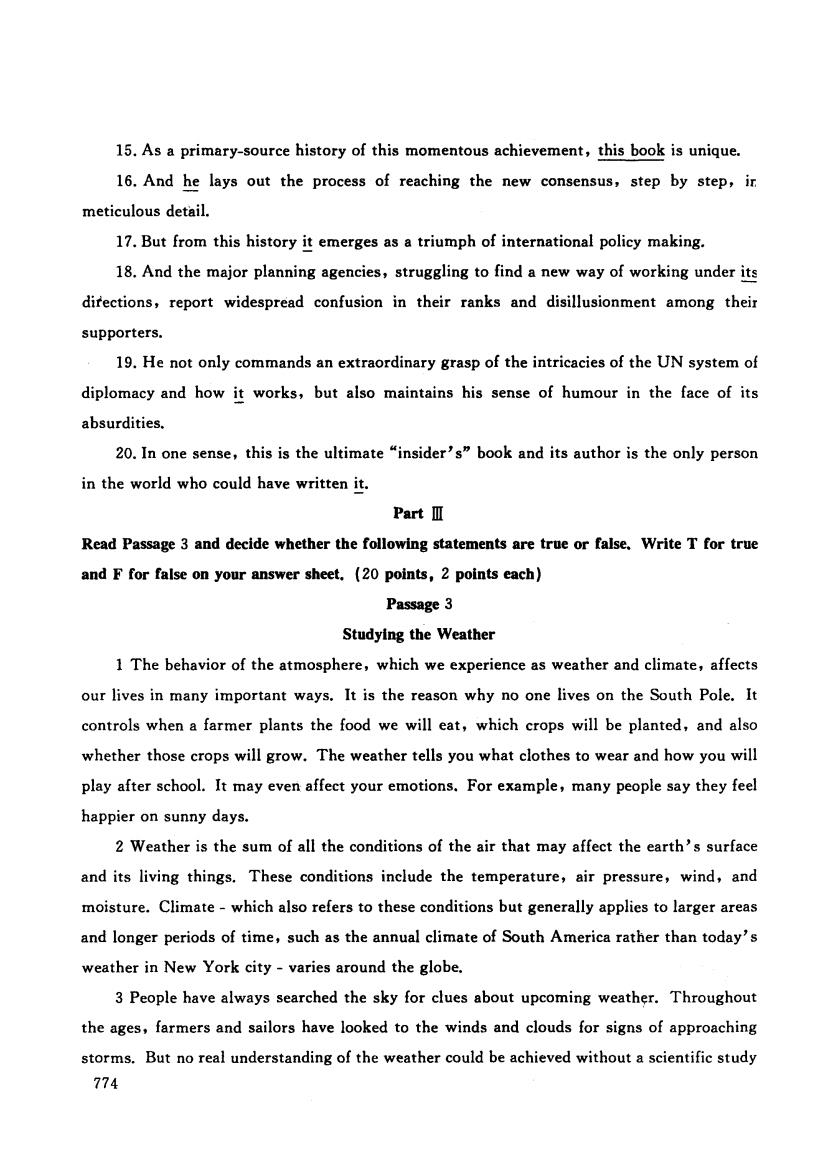
15.As a primary-source history of this momentous achievement,this book is unique. 16.And he lays out the process of reaching the new consensus,step by step,ir. meticulous detail. 17.But from this history it emerges as a triumph of international policy making. 18.And the major planning agencies,struggling to find a new way of working under its directions,report widespread confusion in their ranks and disillusionment among their supporters. 19.He not only commands an extraordinary grasp of the intricacies of the UN system of diplomacy and how it works,but also maintains his sense of humour in the face of its absurdities. 20.In one sense,this is the ultimate "insider's"book and its author is the only person in the world who could have written it. PartⅢ Read Passage 3 and decide whether the following statements are true or false.Write T for true and F for false on your answer sheet.(20 points,2 points each) Passage 3 Studying the Weather 1 The behavior of the atmosphere,which we experience as weather and climate,affects our lives in many important ways.It is the reason why no one lives on the South Pole.It controls when a farmer plants the food we will eat,which crops will be planted,and also whether those crops will grow.The weather tells you what clothes to wear and how you will play after school.It may even affect your emotions.For example,many people say they feel happier on sunny days. 2 Weather is the sum of all the conditions of the air that may affect the earth's surface and its living things.These conditions include the temperature,air pressure,wind,and moisture.Climate-which also refers to these conditions but generally applies to larger areas and longer periods of time,such as the annual climate of South America rather than today's weather in New York city-varies around the globe. 3 People have always searched the sky for clues about upcoming weather.Throughout the ages,farmers and sailors have looked to the winds and clouds for signs of approaching storms.But no real understanding of the weather could be achieved without a scientific study 774
15. As a prima吁source history of this momentous achievement is unique. 16. And he lays out the process of reaching the new consensus, step by step , ir. meticulous detail. 17. But from this history it emerges as a triumph of international policy making. 18. And the major planning agencies, struggling to find a new way of working under its directions, report widespread confusion in their ranks and disillusionment among their supporters. 19. He not only commands an extraordinary grasp of the intricacies of the UN system of diplomacyand how it works, but also maintains his sense of humour in the face of its absurdities. 20. In one sense , this is the ultimate "insider's" book and its author is the only person in the world who could have written it. Part ill Read Passage 3 and decide whether the following statements are true or false. Write T for true and F for false on your answer sheet. (20 points. 2 points 阳ch) Pa孤age 3 Studying the Weather 1 The behavior of the atmosphere , which we experience as weather and climate , affects our lives in many important ways. It is the reason why no one lives on the Sout h Pole. It controls when a farmer plants the food we will eat , which crops will be planted , and also whether those crops will grow. The weather tells you what clothes to wear and how you will play after school. It may even affect your emotions. For example , many people say they feel happier on sunny days. 2 Weather is the sum of all the conditions of the air that may affect the earth' s surface and its living things. These conditions include the temperature , air pressure , wind , and moisture. Climate - which also refers to these conditions but generally applies to larger areas and longer periods of time , such as the annual climate of South America rather than today's weather in New York city - varies around the globe. 3 People have always searched the sky for clues about upcoming weather. Throughout the ages, farmers and sailors have looked to the winds and clouds for signs of approaching storms. But no real understanding of the weather could be achieved without a scientific study 774

of the atmosphere.Such a study depends on being able to measure certain conditions, including pressure temperature,and moisture levels. 4 A true scientific examination of weather,therefore,was not possible until the development of accurate measuring instruments,beginning in the seventeenth century. Meteorology-the science of studying the atmosphere-was thus born in 1643 with the invention of the barometer,which measures atmospheric pressure.The liquid-in-glass thermometer,the hygrometer to measure humidity-the amount of moisture in the air-and the weather map also were invented during the 1600s. 5 With the measurement of these basic elements,scientists began to work out the relationships between these and other atmospheric conditions,such as wind,clouds,and rainfall.Still,their observations failed to show an overall picture of the weather.Such complete weather reporting had to wait two centuries for the rapid transfer of information made possible by the invention of the telegraph during the 1840s. 6 Today,the forecasts of meteorologists are an international effort.There are thousands of weather stations around the world,both at land and at sea.Upper-level observations also are made by weather balloons and satellites,which continuously send photographs back to earth.All of this information is relayed to national weather bureaus, where meteorologists plot it on graphs and analyze it.The information is then given to the public through newspapers and television and radio stations. Questions 21-30 are based on Passage 3. 21.The behaviour of the atmosphere is also called weather. 22.Weather may even influence people's feelings. 23.According to the passage,different places have different climates. 24.A real understanding of weather totally depends on the measuring of temperature. 25.Meterology was born before 1643. 26.The weather map was invented in the seventeenth century. 27.The forecasts of weather is an effort by only developed countries. 28.Nowadays,there are many weather stations at land and at sea. 29.Weather balloons are no longer used for weather forecast. 30.Television and newspapers are the only news media used for weather forecasts. 775
the atmosphere. Such a study depends on being able to measure certain conditions, including pressure temperature. and moisture levels. 4 A true scientific examination of weather, therefore , was not possible until the development of accurate measuring instruments. beginning in the seventeenth century. Meteorology - the science of studying the atmosphere - was thus born in 1643 with the invention of the barometer, which measures atmospheric pressure. The liquid斗n-glass thermometer, the hygrometer to measure humidity - the amount of moisture in the air - and theweather map also were invented during the 1600s. 5 With the measurement of these basic elements, scientists began to work out the relationships between these and other atmospheric conditions, such as wind, clouds, and rainfall. Still. their observations failed to show an overall picture of the weather. Such complete weather reporting had to wait two centuries for the rapid transfer of information made possible by the invention of the telegraph during the 1840s. 6 Today, the forecasts of meteorologists are an international effort. There are thousands of weather stations around the world , both at land and at sea. Upper-level observations also are made by weather balloons and satellites. which continuously send' photographs back to earth. All of this information is relayed to national weather bureaus. where meteorologists plot it on graphs and analyze it. The information is then given to the public through newspapers and television and radio stations. Qu臼tions 21-30 are based on P: 静3. 21. The behaviour of the atmosphere is also called weather. 22. Weather may even influence people's feelings. 23. According to the passage , different places have different climates. 24. A real understanding of weather totally depends on the measuring of temperature. 25. Meterology was born before 1643. 26. The weather map was invented in the seventeenth century. 27. The forecasts of weather is an effort by only developed countries. 28. Nowadays, there are many weather stations at land and at sea. 29. Weather balloons are no longer used for weather forecast. 30. Television and newspapers are the only news media used for weather forecasts. 775

Part I Read Passage 4 and answer the following questions.Make your answers as short and clear as possible.(20 points,4 points each) Passage 4 Christmas 1 December 25 is celebrated as the birthday of Christ.No one is certain why this day was chosen.It was probably because,according to the calendar then in use,December 25 was the time of the year when winter days begin to grow longer in the Northern Hemisphere.The sun-worshippers had celebrated this day as the promise of spring. 2 Over the years,a number of special customs associated with Christmas have grown up.Many of these have been introduced from Europe,while others have their origin in America. 3 Christmas music is loved by all who hear and sing it every year.Christmas songs, bells,and merry music have been a part of Christmas for centuries.The Christmas tree is the symbol of the spirit of Christmas in many homes.Trees were not used in English homes until a German prince married Queen Victoria.The prince had the first decorated Christmas tree set up at Windsor Castle in 1841.The first Christmas trees in the New World were introduced by Hessian soldiers in 1776,during the Revolutionary War.Later German immigrants brought the tradition into wider use in the United States. 4 The custom of decorating a community tree for outdoor display began in the early 1900's and is a favourite custom all over America today.Since 1933,Rockefeller Plaza,in New York City,has put up a giant tree,beautifully decorated with lights.The trees are about 30 metres tall. 5 Some families open their present on Christmas Eve;others wait for the next morning. Some Boys'and girls'presents are placed in stockings and hung at the foot of their beds; others find their gifts under the Christmas tree. 6 Greeting cards began in England.One of the first artists to design and send a Christmas card in 1843 was John C.Horsley.The cards were printed in black and white and colored by hand.About 1,000 of them were sold in London that year.At about the same 776
Part N Read Passage 4 and answer the following qu四tions. Make your answers as short and clear possible. (20 points. 4 points 阳ch) Passage 4 Christmas 1 December 25 is celebrated as the birthday of Christ. No one is certain why this day was chosen. It was probably because , according to the calendar then in use , December 25 was the time of the year when winter days begin to grow longer in the Northern Hemisphere. The sun-worshippers had celebrated this day as the promise of spring. 2 Over the years, a number of special customs associated with Christmas have grown up. Many of these have been introduced from Europe , while others have their origin in America. 3 Christmas music is loved by all who hear and sing it every year. Christmas songs, bells, and merry music have been a part of Christmas for centuries. The Christmas tree is the symbol of the spirit of Christmas in many homes. Trees were not used in English homes until a German prince married Queen Victoria. The prince had the first decorated Christmas tree set up at Windsor Castle in 1841. The first Christmas trees in the New World were introduced by Hessian soldiers in 1776 , during the Revolutionary War. Later German immigrants brought the tradition into wider use in the United States. 4 The custom of decorating a community tree for outdoor display began in the early 1900's and is a favourite custom all over America today. Since 1933 , Rockefeller Plaza , in New York City , has put up a giant tree , beautifully decorated with lights. The trees are about 30 metres tall. 5 Some families open their present on Christmas Eve; others wait for the next morning. Some Boys ' and girls' presents are placed in stockingsand hung at the foot of their beds; others find their gifts under the Christmas tree. 6 Greeting cards began in England. One of the first artists to design and send a Christmas card in 1843 was John C. Horsley, The cards were printed in black and white and colored by hand. About 1 ,000 of them were sold in London that year. At about the same 776
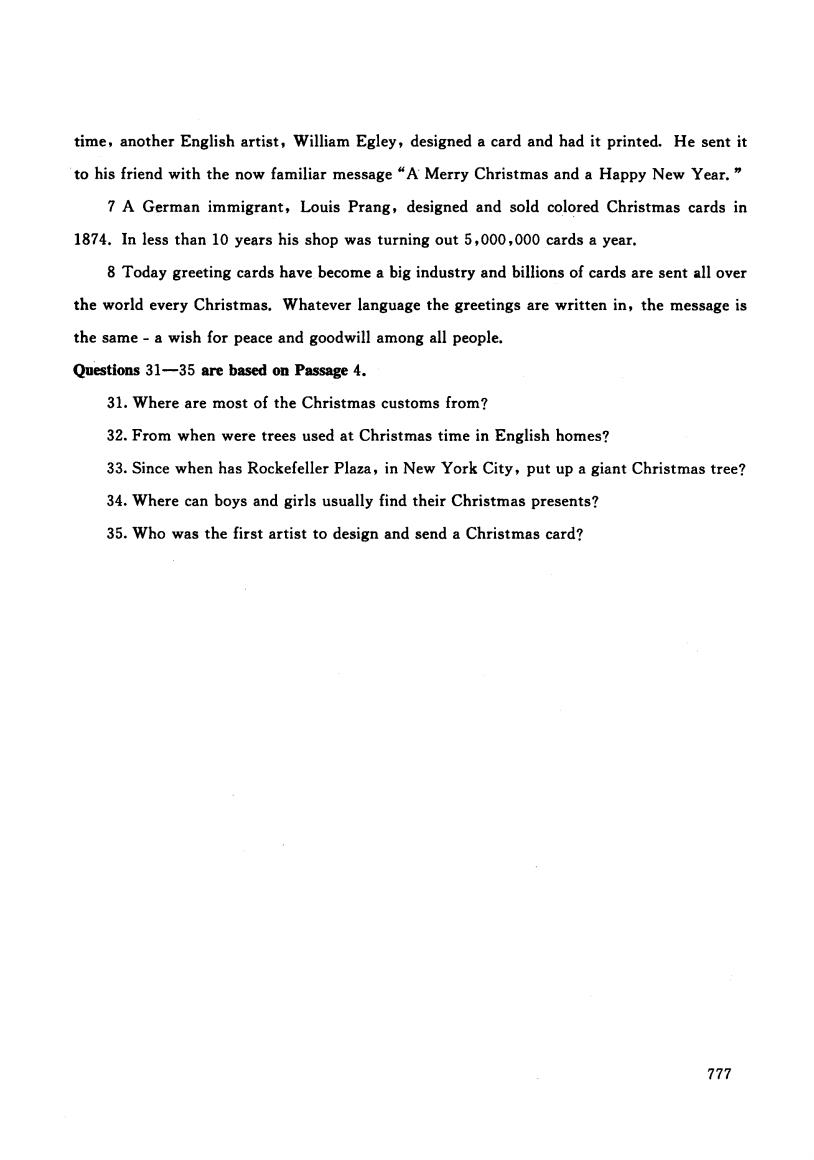
time,another English artist,William Egley,designed a card and had it printed.He sent it to his friend with the now familiar message"A Merry Christmas and a Happy New Year." 7 A German immigrant,Louis Prang,designed and sold colored Christmas cards in 1874.In less than 10 years his shop was turning out 5,000,000 cards a year. 8 Today greeting cards have become a big industry and billions of cards are sent all over the world every Christmas.Whatever language the greetings are written in,the message is the same-a wish for peace and goodwill among all people. Questions 31-35 are based on Passage 4. 31.Where are most of the Christmas customs from? 32.From when were trees used at Christmas time in English homes? 33.Since when has Rockefeller Plaza,in New York City,put up a giant Christmas tree? 34.Where can boys and girls usually find their Christmas presents? 35.Who was the first artist to design and send a Christmas card? 777
time , another English artist , William Egley , designed a card and had it printed. He sent it to his friend with the now familiar message"A Merry Christmas and a Happy New Year. " 7 A German immigrant, Louis Prang , designed and sold colored Christmas cards in 1874. In less than 10 years his shop was turning out 5 ,000 ,000 cards a year. 8 Today greeting cards have become a big industry and billions of cards are sent all over the world every Christmas. Whatever language the greetings are written in , the message is the same - a wish for peace and goodwill among all people. Qu四tions 31-35 are based on 腿ge 4. 31. Where are most of the Christmas customs from? 32. From when were trees used at Christmas time in English homes? 33. Since when has Rockefeller Plaza , in New York City, put up a giant Christmas tree? 34. Where can boys and girls usually find their Christmas presents? 35. Who was the first artist to design and send a Christmas card? 777